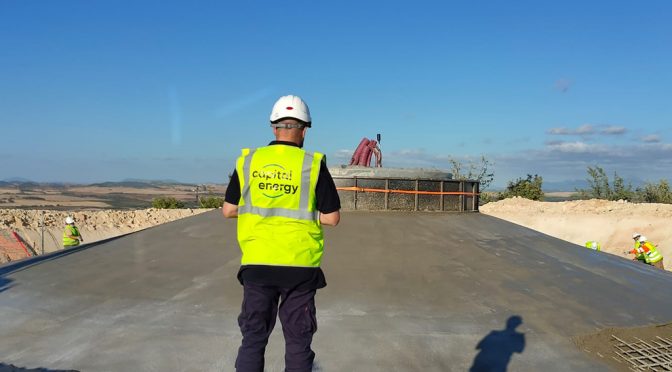This Spanish company will be in charge of the engineering, supply, construction and commissioning of this new wind energy installation, as well as its evacuation infrastructures, over the next nine months. The wind farm will have an initial power of 22.5 megawatts (MW) and its five wind turbines, of the General Electric Cypress model, will supply clean energy to some 27,000 homes and will prevent the emission into the atmosphere of more than 25,000 tons of CO2 by anus.
Located in the municipality of Jerez de la Frontera, El Barroso will have an economic impact on local coffers, as well as through leasing contracts, of approximately 150,000 euros per year
Capital Energy, a Spanish energy company founded in 2002 and whose vocation is to become the first 100% vertically integrated renewable operator in the Iberian Peninsula, continues to take steps to strengthen the development of its clean energy project in Andalusia with the award of the construction of its second wind farm in this autonomous community: El Barroso.
Capital Energy has just closed the contract with the Elecnor Group whereby this Spanish infrastructure company will be in charge of the engineering, supply, construction and commissioning of this new renewable energy facility, as well as its infrastructure for evacuation, over the next nine months.
Located in the province of Cádiz, the El Barroso wind farm will have an initial power of 22.5 MW and its five wind turbines, of the General Electric Cypress model, will be capable of supplying about 65,000 megawatt hours (MWh) of clean energy per year. , equivalent to the consumption of some 27,000 homes in the region, and to avoid, likewise, the emission into the atmosphere of more than 25,000 tons of CO2 per year.
El Barroso, located in the municipality of Jerez de la Frontera, will involve an investment of more than 30 million euros and will promote the creation of around 150 direct jobs during the peak periods of its construction. Likewise, in the operation and maintenance phase, it is expected to permanently employ five professionals in the area.
It should be noted, in this regard, that, in line with its commitment to the economic and social development of all the territories in which it carries out its activity, Capital Energy has signed a collaboration agreement with the Jerez City Council to promote contracting of local workforce linked to the construction of this wind farm.
On the other hand, this renewable installation will have an annual economic impact on local coffers (IBI and IAE, mainly), as well as through leasing contracts, of approximately 150,000 euros.
Andalusia, a key community for Capital Energy
Andalusia is essential for the development of Capital Energy’s clean energy project. Not surprisingly, the company develops more than 1,300 megawatts (MW), both wind (about 900 MW) and solar (approximately 450 MW), in this autonomous community, whose development would involve an investment of more than 980 million euros.
Capital Energy is promoting the construction of 26 renewable projects, 21 wind and five photovoltaic, in six Andalusian provinces. Those with the most megawatts and facilities are Almería (460 MW and 8 projects) and Granada (394 MW and 4). They are followed by Málaga (282 MW and 7), Seville (157 MW and 5), Cádiz (28 MW and 1) and Huelva (26 MW and 1).
The company is progressing with the works of its first wind farm in Andalusia: Loma de los Pinos, with an installed capacity of 39 MW and located in the Sevillian town of Lebrija. Like El Barroso, this renewable facility, whose entry into operation is scheduled for the first half of 2022 and which already has a long-term power purchase agreement (PPA), will equip General Electric turbines.
Its seven wind turbines, which will arrive at the site during the last quarter, will generate 103,000 megawatt hours (MWh) per year, enough to supply clean electricity to 40,000 Andalusian homes. Loma de los Pinos will also prevent the emission into the atmosphere of more than 41,000 tons of CO2 each year.


